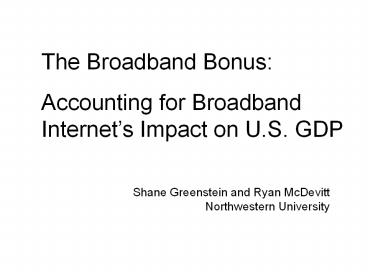Shane Greenstein and Ryan McDevitt - PowerPoint PPT Presentation
1 / 9
Title:
Shane Greenstein and Ryan McDevitt
Description:
Accounting for Broadband Internet's Impact on U.S. GDP. What is the economic value created by a new good? ... Potentially large economic effects as a new ... – PowerPoint PPT presentation
Number of Views:85
Avg rating:3.0/5.0
Title: Shane Greenstein and Ryan McDevitt
1
The Broadband Bonus Accounting for Broadband
Internets Impact on U.S. GDP
- Shane Greenstein and Ryan McDevitt
- Northwestern University
2
Motivation
- What is the economic value created by a new good?
- Potentially large economic effects as a new
technology replaces old. - In 2001 45m hh use dial up, 10m use broadband.
- In 2006 34m hh use dial-up, 47m use broadband.
- How much economic value was created through the
diffusion of broadband? - Internet access is a big industry (39B in GDP in
2006). Merits attention for its own sake. - Questions about the extent of economic gains
stemming from the deployment of a new technology.
- Replacing dial-up creates additional
complication.
3
Our Papers Objective
- Provide benchmark estimates for policy
discussions - Relentlessly quantitative. Assembles best public
data. - Only examine households, not businesses. Only US.
- Two traditional measures in economics.
- Revenue growth ? GDP growth or producer surplus.
- Buyer willingness to pay (WTP) ? consumer
surplus. - Compare revenue consumer surplus w/ broadband
to what would have happened w/o broadband. - Robert Fogel contribution to growth is
contribution above what would have occurred in
absence of new technology. - Compare with a counter-factual world with only
dial-up.
4
Main Results
- When properly accounted for, the use of broadband
in households accounted for approx 20 - 22B in
new revenue in 2006, but that is not the same as
created value. - Approx 15B of newly created value.
- Approx 8.3B to 10.5B is new revenue for firms.
- Approx 6.7B to 4.8B is consumer surplus, which
is not measured as a part of GDP. - Equivalent to approx 1.6 to 2.2 price decline,
earlier than measured by official price indices. - These estimates are much lower than others -- by
an order of magnitude. Why? - Popular forecasts are not grounded in or
calibrated against historical data, as ours
are. - We strictly employ traditional economic methods
and Fogels conceptualization of the issues.
5
What Our Calculations Miss
- Growth externalities not considered by parties
during the transaction. - Suppliers Benefit to Cisco from selling more
Wi-Fi equipment to users. Benefit to Amazon from
additional sales b/c broadband users experience
more satisfying service. Benefit to Google from
more ad sales b/c users stay on line longer. - Users Unanticipated slowness that one neighbors
use imposes on another, or benefits that one
persons participation in a p2p network confers
on another (as long as there is no membership
fee). - Still important to account for countervailing
effects, however.
6
Summary of Findings Suppliers
- Summary 59 to 54 of broadband revenue is
replacement of dial-up second lines. - New revenue is 10.6B in 2006 if price 40.
That is 46 of 22B for households. - 8.3B when P 36, which is 41 of 20.3B.
- Aggressive conversion (too high) ? 2.3B lower,
while unaggressive (too low) ? 0.9 higher. - Not an estimate of profitability.
- Can see cable is big grower, dial-up ISPs biggest
loser. Telco gains small b/c also lose second
line. - Revenue levels consistent w/ cost estimates for
upgrade (e.g., 150-400 per household).
7
Summary of Findings Consumers
- CS approx 6.7B to 4.8B in 2006.
- 44 or 32 of approx 15B total value created.
- Aggressive conversion (too high) reduces total
surplus by 0.8, while unaggressive (too low)
increases 0.6, assuming 40 price, so the
estimates are much more sensitive to assumption
about pricing than conversion. - Cautionary notes
- No adjustment for inelastic demanders or AOLs
pricing. - This data is from 02. Would recent data from
users w/ recent experience show greater
unwillingness to give up Broadband?
8
Implications
- Rural broadband expensive relative to likely
benefits. - Broadband for Boondocks
- A decade of private-led build-out and retrofit of
existing infrastructure by cable co. local
telcos have upgraded everywhere that is
cost-viable. - Leaves high cost retrofits or green field
upgrade. - Billion dollars will not go very far in reaching
high-cost households. - Next generation of upgrade just starting to
happen. - Next five years Either 3G/4G or WiMax.
- Very unclear how to measure benefits.
9
Future Work
- Broadband diffusion world wide in need of a
similar approach to measurement. - Potential for extending simple model to
world-wide broadband data. - Next step estimate more systematic model of the
demand for broadband. - Give a sense of the world-wide gains.































![[PDF] DOWNLOAD A Drink with Shane MacGowan PowerPoint PPT Presentation](https://s3.amazonaws.com/images.powershow.com/10077327.th0.jpg?_=20240712029)